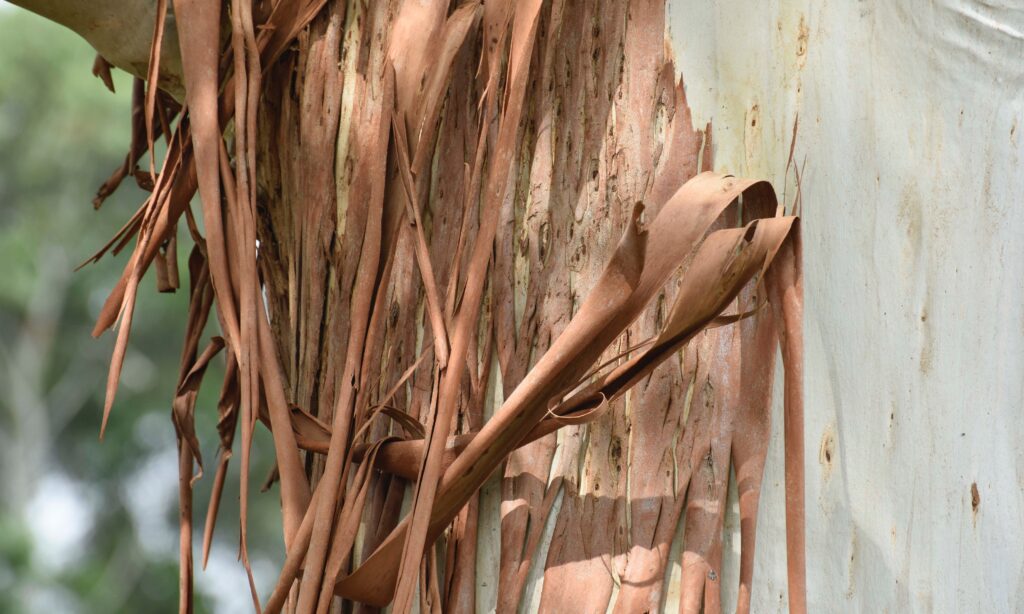
The ladies are loosening their corset!
Every year in the summer half-a-dozen or so anxious fellow #gumnuts call us about the state of their trunks. Not the swimming kind, but the barky kind. ‘There’s something seriously wrong with my Eucalyptus…’ ‘My bark is splitting. Have I got a disease?’ ‘It looks like peeling paint!
No worries – your tree is behaving perfectly. It is stripping off for summer; peeling its bark. In the UK, your Euc may do this annually any time between June-Aug. The trunk will change colour such as yellow-cream, orange/rust or turquoise, usually first on the southern or western side of the tree. This is an indication of the impending seasonal ritual.
Eucalyptus bark varies depending on the age of the tree. Young trees don’t really attain bark, as we know oak-tree-bark, until they are at least five to eight years old. Prior to this, they have a spongy periderm which is a bit like orange peel; it will scratch off with your thumbnail. Every year, the tree trunk expands, putting on weight, laying down fibre and it grows an extra layer of bark. The outer, older layer is then shed. E. dalrympleana is known as the broad-leaved kindling bark for good reason – Great stuff for lighting the barbie!
Of the 800 or so Eucalyptus species, bark classification falls into roughly two camps;
The persistent rough type of stringybarks, boxes, peppermints and ironbarks.
The shedding smooth type like brittle gums and scribbly gums.
The new under-bark is often a bright and interesting colour before darkening. E nicholii splits to reveal a striking eau-de-nil prior to resuming its foxy-red flaky bark. The brittle gum E. mannifera subsp. elliptica turns an intense flamingo pink, peels to reveal a silky clotted cream under-bark before returning to its classic bone-white trunk. Blue gums shed in papery strips displaying patches of fresh cinnamon. Snow gums cast off their bark in jig-saw shaped flakes of pewter.
Depending on the species, the bark might fall in plates, large sections, or stringy lengths, but trying to identify Eucs by their outer clothing is a dark art. The Eucalyptus is from a diverse family, not all share the same type of bark.
The Rough-barks (tricky to identify) retain a thick protective layer of coarse bark to ward off immolation.
Iron-barks have a tough blackened furrowed carapace often infused with kino or gum resin whereas the Peppermints and Boxwoods have really short fibres. E. aggregata sheds in tessellated small pieces to reveal a fashionable ‘coffee n cream’ chequered under-bark.
The Stringy-barks shed in long spongy strips (although not all trees with stringy bark are Stringy-barks!) There about 30 Stringy-bark species in eastern Australia, but the term is used for many similar species that are not closely related botanically. The Darwin stringybark used in Aboriginal bark paintings in the Northern Territory is a false stringybark. Confused? – join the club!
There are also the ‘half-barked’ Eucalypts, such as the candle-bark gum Eucalyptus rubida. The lower part of the tree has rough flaky bark (normally a dark colour); whilst the upper limbs are a tactile smooth affair in pure white. These half-barked ladies often grow in the regions of Oz where there are only grass fires or lower storey fires rather than a full-on raging inferno, so they have no need to put effort into growing a full metal jacket

The jury is out to lunch on this one. Several theories are put out there, such as:
Shedding bark is a means of divesting the host of moss, lichen, fungi and parasites. Scribbly gums are plagued with larvae of the Australian Scribbly gum Moth doodling crazy calligraphy on the trunks (you couldn’t make this stuff up!).
The Tasmanian blue gum E. globulus has a neat trick whereby its bark cells are able to photosynthesize and produce food for the tree when it has been defoliated by fire, thus allowing it to thrive in less-than-ideal climates.
The above may well be true, but our own view at Hardy Eucalyptus is as follows:
Eucalyptus are very fast-growing hardwood trees. They are highly adapted to rapidly convert soil minerals and carbon into wood fibre. This is what makes them excellent at removing atmospheric CO2; they are the carbon-busters. The last thing this tree needs is to be constrained by tight-fitting bark. To speedily expand your waistline, you need quick-release clothing…I believe!
A sappy young tree carries semi-protective but spongy periderm which allows for rapid growth in the early years, but it leaves them vulnerable to be chewed off before they reach their prime.
Whereas older Eucalyptus have invested a great deal in their woody collateral and need solid protection, in the form of rigid bark, from munching predators. Eucs lay down carbon-rich heart-wood every autumn and timing is crucial. What they require is a quick and easy way to expand their girth in preparation for the autumn augmentation without having their barky defences compromised for too long. What better way then but to shed their tight-fitting outer-apparel mid-late summer and re-grow a new larger one just before winter?
So come next July-August, if your trunk becomes a bit loose, wrinkly and a lighter shade of pale; have no fear. It’s just your Eucalypt loosening up her corset!
References
1) https://www.abc.net.au/news/science/2018-01-26/eucalyptus-trees-an-iconic-australian/9330782?nw=0